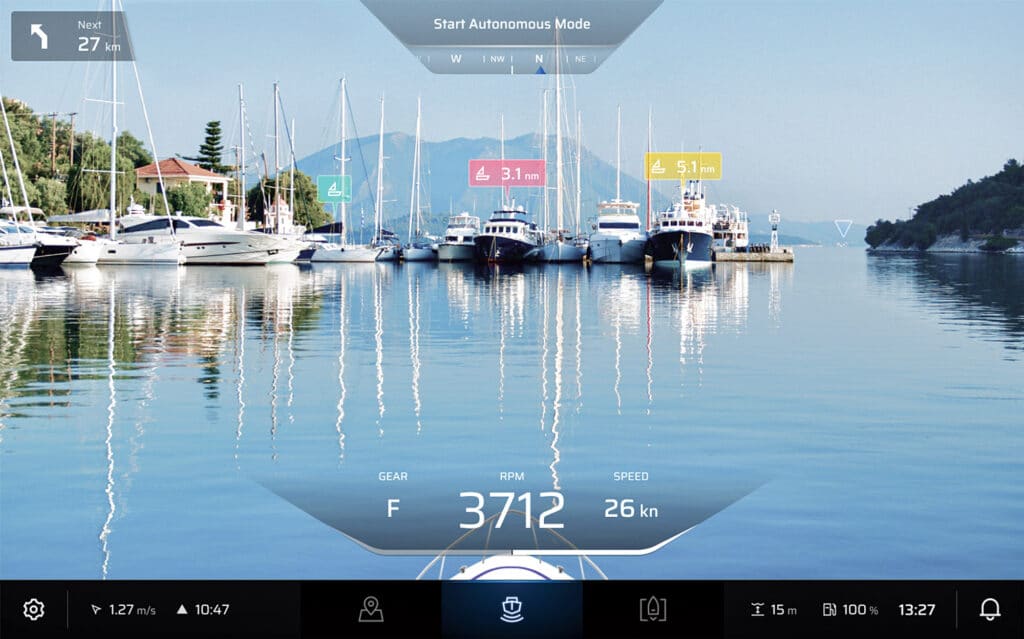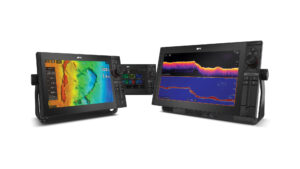
It’s one thing to experience computer-assisted docking, but it’s different to ride aboard a vessel that’s autonomously negotiating the nautical road. I learned this during an on-water demo of NeuBoat technology from Avikus at the recent Fort Lauderdale International Boat Show. Our human pilot guided the demo boat out of its slip and into the Stranahan River. Minutes later, his hands left the helm, not to return. While it initially felt strange to place so much trust in silicone and sensors, trepidation morphed into amazement as we transited under the Southeast 17th Street bridge and into Lake Mabel. We passed hundreds of millions of dollars’ worth of gleaming fiberglass, aluminum and steel waterlines, but NeuBoat plotted a safe course through all of it and then back to, and into, the slip.
Like it or not, artificial intelligence is here, and it will only become a bigger, more integrated part of our world in the future. Hyundai Heavy Industries, the world’s largest shipbuilder and the parent company of Avikus, is already using autonomous capabilities to navigate ships across oceans, albeit with human oversight. While the NeuBoat isn’t the only autonomous-vessel technology afloat, it’s the only solution created by the commercial-marine sector with the parallel intention of innovating for the recreational-marine market. Avikus plans to offer two AI-assisted products, which can each be spec’d with two levels of operational capability.
The first is NeuBoat Navigation, which should be released in the second half of this year. It is designed to help human operators who are directly controlling their vessels make more situationally aware decisions. The basic option delivers navigational assistance through augmented reality to help skippers make smart choices, while the more advanced option provides navigation assistance along with camera- and sensor-collected informational assistance while docking.
The second product is NeuBoat Navigation and Docking Control, which Avikus plans to release in 2024. It’s a step up. Its basic option will include AI-controlled route planning, navigation and collision avoidance, with humans providing oversight. Its advanced option adds AI-controlled docking.
While NeuBoat’s operating system and AI are scalable, the two systems (and their options) have different hardware requirements. NeuBoat Navigation installations have a black-box AI recognition processor and NeuBoat’s graphical user interface (GUI), which can be displayed on a compatible multifunction display or an Android-based tablet or smartphone. For a sensor, there is a forward-looking daylight camera and a forward-looking light-detection-and-ranging (lidar) sensor. If applicable, NeuBoat can incorporate cameras for thermal imaging. Additional cameras and sensors can be added.
NeuBoat Navigation and Docking Control-equipped yachts will employ the same AI-recognition processor and GUI, but will also have an autonomous-control processor and an engine-interface module. Steering is via the vessel’s networked autopilot. The system will also use five to 10 daylight cameras and at least two lidar sensors for 360-degree situational awareness.
Both systems require either two networked global navigation satellite system receivers or a networked satellite compass to determine the vessel’s position, heading and rate-of-turn information. The cameras collect imagery that’s sent to the system’s AI-recognition processor, where it’s compared, in near real time, with a growing image database that includes at least 2.5 million images. The system then uses a form of AI called computer vision to sort objects into one of eight buckets: motorboats, vessels, sailing yachts, rowboats, channel markers, buoys, structures or “other.”
“We determine obstacles in the image input from the front [camera] in real time with AI based on the pre-learned image data,” says Lim Dohyeong, CEO of Avikus.
The video stream is also sent to a helm display, where it can be seen by human operators. For navigation, the system can apply augmented-reality-style information tags above camera-captured targets, advising on their range and target type.
As mentioned, both systems employ a lidar sensor or sensors to determine precise distances. NeuBoat Navigation and Docking Control, however, also uses lidar to create distance maps between the sensor and objects in its surrounding environment (for example, docks and pilings) during autonomous docking.
“It scans the surrounding environment in real time whenever it enters or leaves the port,” Dohyeong says. The system basically creates a map from scratch each time—even if the dock is one that the yacht’s owners often frequent—to account for dynamic variables.
In addition to video feeds, part of NeuBoat’s GUI includes electronic cartography and a chartplotter like page view. The information serves as a database that the system uses for auto-routing and autonomous navigation. (For my demo ride, the system used an official electronic navigation chart; however, Avikus plans to integrate with third-party vector-cartography products, including C-Map and Navionics.) This presentation also allows a human operator to understand the yacht’s position quickly, relative to landmasses, channels, navigational marks and other vessels.
As with other self-learning, AI-based systems, the more time NeuBoat spends navigating and capturing video imagery, the better it should perform. NeuBoat will be supported by biannual software updates.
While NeuBoat products have yet to be released, Avikus is working with several marine-electronics manufacturers on projects that will allow NeuBoat to incorporate third-party equipment, including AIS and radar, for collision-avoidance work. As an example, Avikus has signed a memorandum of understanding with Raymarine to collaborate on integrating NeuBoat technology with Raymarine’s product portfolio and to explore the future of autonomous recreational vessels overall.
As of this writing, Avikus plans to let owners purchase NeuBoat Navigation as OEM equipment aboard a new build or in the aftermarket during a refit. Dohyeong says NeuBoat Navigation can even be added as a DIY project. Owners interested in NeuBoat Navigation and Docking Control systems will have to wait until they’re offered aboard new builds, but Dohyeong says aftermarket upgrades could become available for that system too, as its auto-calibration technology advances.
While adoption rates and boaters’ willingness to entrust potentially consequential operations to artificial intelligence remain an open-ended question, our test boat successfully navigated and self-docked. The gleaming nearby waterlines, I’m happy to report, remained unaffected by our autonomous passage.
Heavy Metal
In addition to NeuBoat, Avikus builds HiNAS 2.0 (that’s Hyundai intelligent Navigation Assistant System) for commercial mariners. In 2022, HiNAS 2.0 helped navigate a carrier full of liquefied natural gas across an ocean with human oversight. The ship’s fuel efficiency increased by about 7 percent. Greenhouse-gas emissions dropped by about 5 percent.









